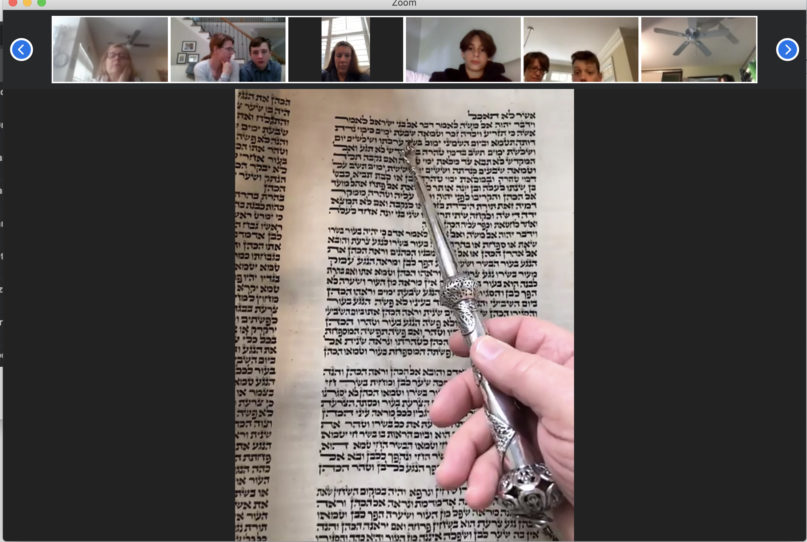(RNS) — Stop me if you’ve heard this one.
On a cold December day, a man enters the post office. He steps up to the counter and asks to purchase the new Hanukkah stamp.
“What denomination?” the clerk asks.
To which the customer groans a response: “Don’t tell me that it’s really come to this!”
I think that joke is funny.
But I also think that the joke is increasingly a relic of an American Jewish past that might no longer be sustainable.
This past week, the subject of Jewish denominations was in the news. The Forward reported that Union for Reform Judaism President Rabbi Rick Jacobs mused on the possibility of the Reform movement “merging parts of its operations with those of other liberal Jewish movements.” In great pain, the Union for Reform Judaism had to lay off a great many staff members — a grievous situation for all concerned.
Some are saying that The Forward misquoted Jacobs or took his remarks out of context.
Nevertheless, I believe that Jacobs is on to something — and I have believed so for quite some time.
I believe that one of the long-term results of COVID-19 and its accompanying financial challenges to Jewish communal life could be the creation of a common American non-Orthodoxy.
First, the cultural differences between the Reform and Conservative movements are shrinking (even more so with the smaller non-Orthodox movements). In 2017, the Conservative movement allowed individual synagogues to grant membership to non-Jews. The Jewish Theological Seminary came out in support of the rights of transgender students to use the public school restrooms of their choice.
Such developments, and others, prompted Roberta Rosenthal Kwall to write:
The institutional structures of both movements and their affiliated members increasingly share the same cultural norms, particularly with respect to liberal social issues … a growing number of Conservative and Reform Jews agree on hot-button social issues such as interfaith and same-sex marriage, ordination of gay rabbis, and descent … given the convergence between the movements, the real question is whether Conservative Judaism can maintain and further a religious identity and mode of observance distinct from that of Reform?
Second, non-Orthodox rabbis (and some modern Orthodox rabbis as well) increasingly share worldviews on matters of ritual, social justice, etc. Perhaps I think that because I study at the Shalom Hartman Institute in Jerusalem, which attracts rabbis across the denominations who readily imbibe pluralism, diversity, creativity and social justice — despite the nuances of their attachment to halacha.
So, where are there possible merger/cooperative opportunities for Reform and Conservative synagogues (the same could be said of Reconstructing Judaism, as well, with perhaps Jewish Renewal “signing on” as well)?
- Merge local Reform and Conservative religious schools. One educational director; one faculty. Consider: You have a community with two small synagogues — Reform and Conservative — of the same size. Pure economic considerations would prompt you to ask: Why should there be two schools, with a grand total of 100 students? Why not merge them? It is happening in various places around the country.
- Merge synagogue early childhood programs. Jewish Community Centers have shown that ideology doesn’t mean a thing to the paste-eating crowd. Especially because most pastes would not be kosher, anyway.
- Merge local youth groups. One youth adviser, rather than two. One larger group of kids. Would the resultant group be affiliated with United Synagogue Youth (the Conservative youth movement)? Or with the North American Federation of Temple Youth (the Reform youth movement)? Or, with B’nai B’rith Youth Organization (a nondenominational, “just Jewish” youth program)? Can there be dual national affiliations? Consider: Why wouldn’t we be doing everything possible to bring Jewish kids together?
- Move in together. It is already happening in many places around the country. Reform and Conservative, or Reform and Reconstructing Judaism, synagogues are sharing synagogue space and financial resources.
You want to think bigger?
- Merge seminary programs. Merge Hebrew Union College-Jewish Institute of Religion (Reform) and Jewish Theological Seminary or American Jewish University programs (Conservative) in New York, Los Angeles and Jerusalem. Keep HUC-JIR in Cincinnati. (I do not know enough about the workings of Reconstructing Judaism to adequately devote space to them.) Consider: Is there not merit in budding rabbis, cantors, educators and communal professionals studying together? “Who is wise? The one who learns from all people.”
On a sheer human and intellectual level, why shouldn’t the American Jewish community expose its students to the “best and the brightest” academics — across the board? If anything, Zoom has shown us how possible it is, how space and time are less important than we had once thought.
Here comes the third rail of American Jewish institutional thinking …
- Merge the seminaries. As many observers have wondered, will American Judaism continue to support these massive educational structures, their buildings, their staffs? Will separate educational institutions make ideological, pedagogical and economic sense? Imagine non-Orthodox students studying together, with the finest scholars in the Jewish world, and then pursuing employment in the movement of their choice (leaving aside, for a moment, what those movements will eventually look like).
I have long applauded, supported and sustained the real differences between the non-Orthodox Judaisms. Those differences, subtle as they might be to the naked eye, still matter.
The post-COVID-19 Jewish future is going to look very different.
The shape and complexion of that difference is now on the table, and up for discussion and planning.
Years ago, when things were going well, when our demography was strong, we needed a clone of the biblical Joseph, who could have taught us how to save our resources — not all of them financial — for the coming lean years.
The lean years are here.
We now need a Joseph. We need a Joseph who can dream and interpret the dreams of others. We need concrete, coordinated vision and strategy.
Where is our Joseph?






